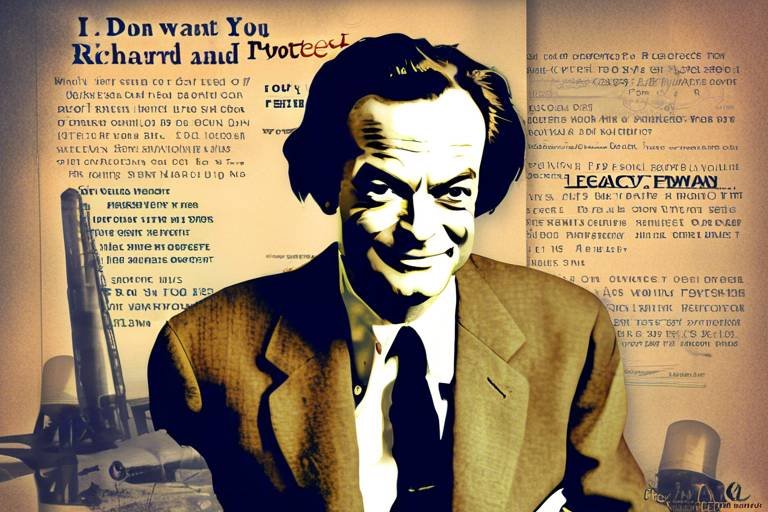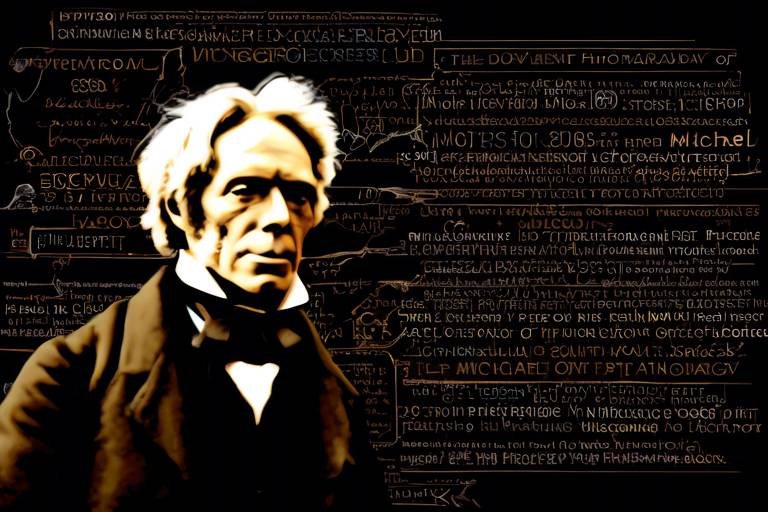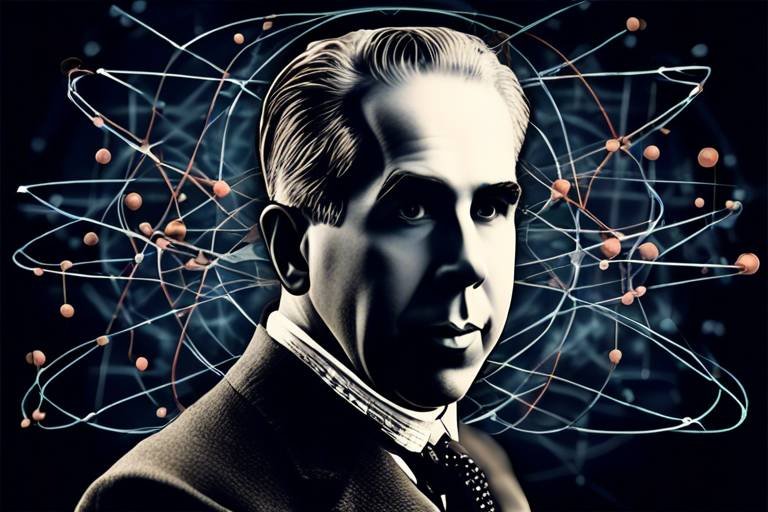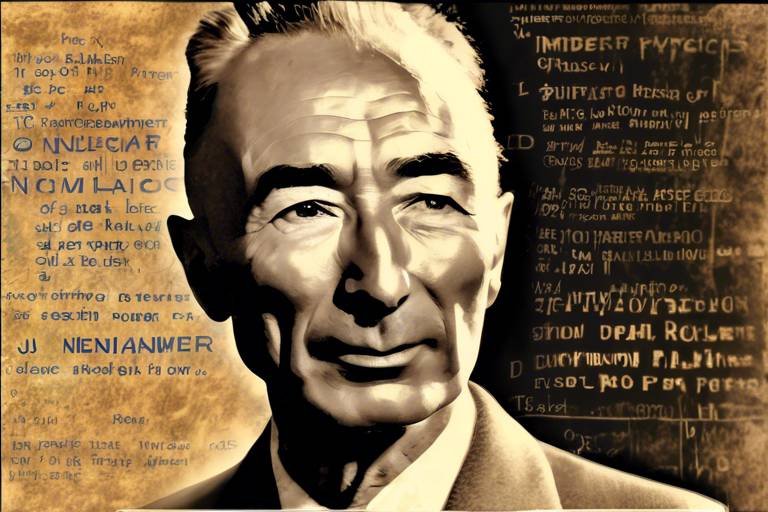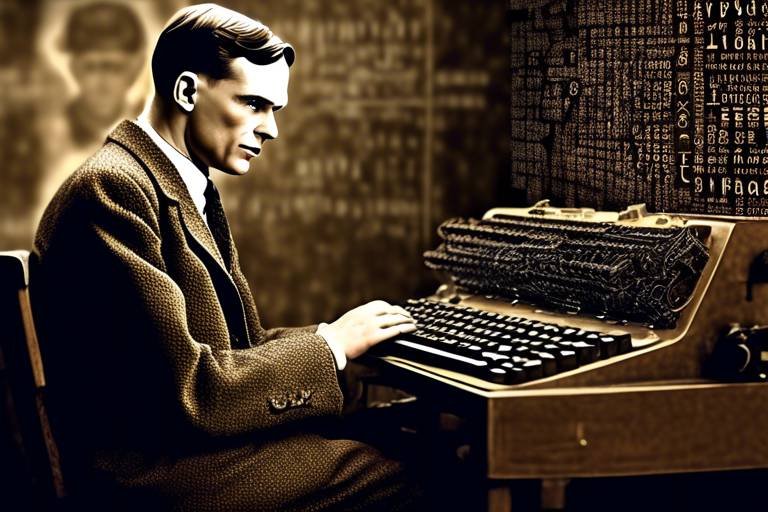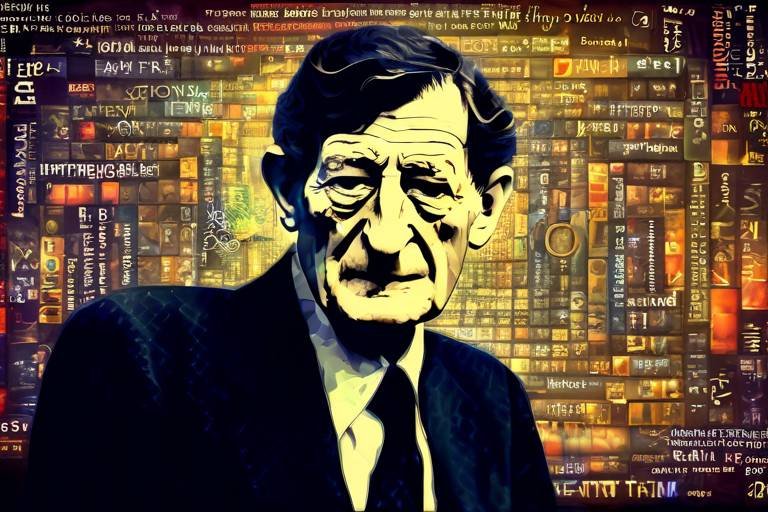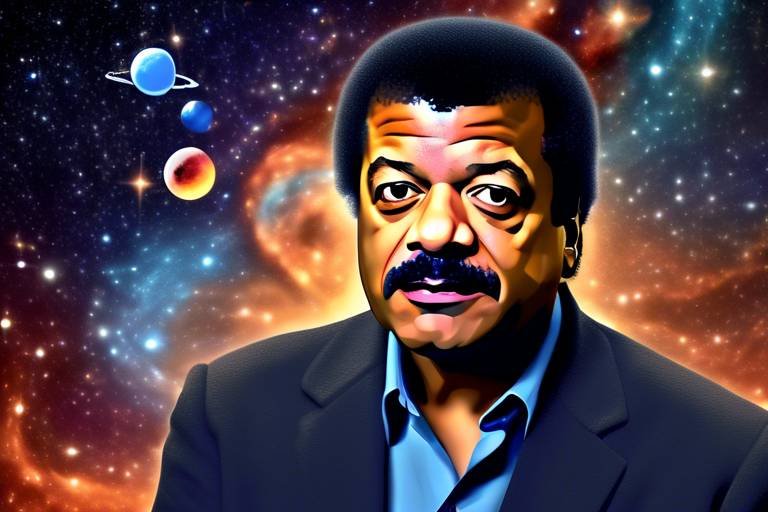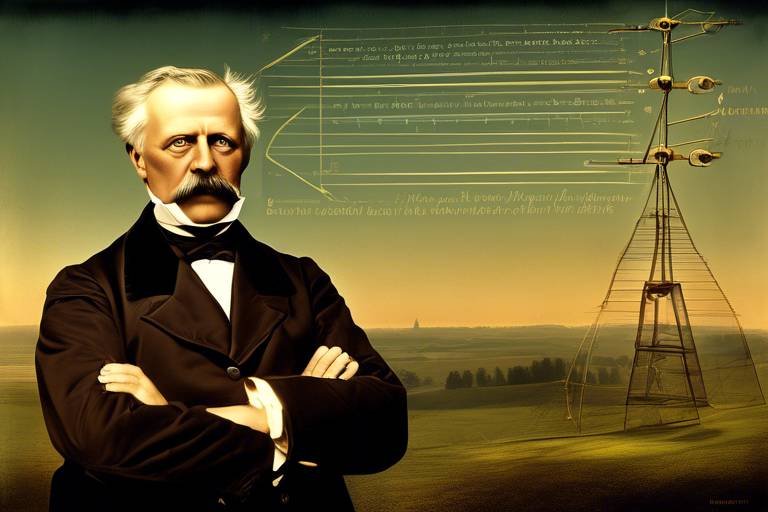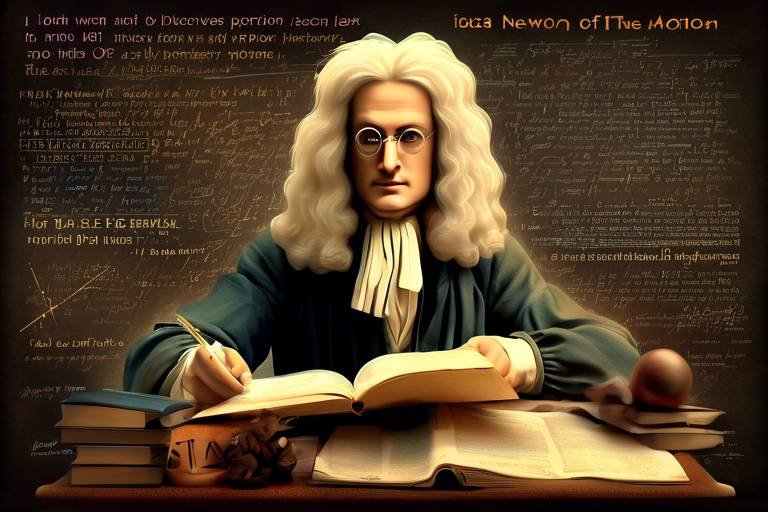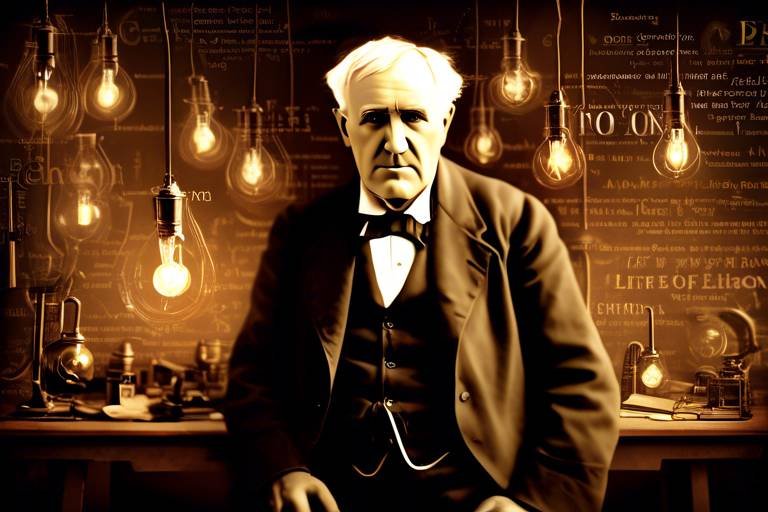The Legacy of Richard Feynman and the Manhattan Project
Richard Feynman, a name that resonates through the corridors of physics, is not just a figure of scientific brilliance but a vibrant personality who transformed the way we perceive the universe. His contributions to the Manhattan Project during World War II were pivotal in the development of the atomic bomb, a project that changed the course of history. But Feynman's legacy extends far beyond his technical achievements; it intertwines with the very fabric of modern physics and popular culture.
Born in 1918 in Queens, New York, Feynman's journey into the world of science began at an early age. His curiosity was insatiable, leading him to explore everything from electronics to the mysteries of quantum mechanics. His education at the Massachusetts Institute of Technology (MIT) and later at Princeton University laid a solid foundation for his future contributions. Feynman's early experiences shaped a mind that would later challenge conventions and inspire countless individuals.
During the Manhattan Project, Feynman was not just another scientist in a lab coat; he was a problem solver, a thinker, and a communicator. His role primarily focused on the development of the bomb's detonation mechanism, where his analytical skills shone brightly. He approached complex problems with a unique flair, often using analogies and visual aids to simplify concepts for his colleagues. This ability to demystify the intricacies of nuclear physics fostered a collaborative spirit among the scientists, making Feynman a central figure in discussions that would ultimately lead to the creation of the atomic bomb.
However, the project was not without its challenges. Feynman and his peers grappled with the ethical implications of their work. The weight of creating a weapon of mass destruction hung heavily over them. Feynman often reflected on these moral dilemmas, recognizing the profound impact their invention would have on humanity. This awareness added a layer of complexity to his legacy, as he became not only a scientist but also a thinker who questioned the implications of scientific advancements.
After the war, Feynman's contributions to physics continued to flourish. He made groundbreaking advancements in quantum electrodynamics, a field that explores the interaction between light and matter. His work in this area earned him the Nobel Prize in Physics in 1965, solidifying his place among the giants of science. Feynman's influence didn’t stop at research; he was also passionate about education. His lectures and writings, particularly the renowned Feynman Lectures on Physics, transformed the way physics is taught, making it accessible and engaging for generations of students.
Feynman's charisma and storytelling prowess transcended the academic world, catapulting him into popular culture. He became a cultural icon, known for his ability to communicate complex scientific concepts in a relatable manner. Through television appearances, interviews, and books, Feynman captured the imagination of the public, making science feel less like an abstract concept and more like an exciting adventure. His legacy is a testament to the idea that science is not just about equations and theories; it’s about understanding the world around us and sharing that understanding with others.
In conclusion, Richard Feynman's legacy is a multifaceted one. He was a brilliant physicist, a passionate educator, and a cultural icon who made significant contributions to the Manhattan Project and beyond. His ability to blend science with storytelling has left an indelible mark on both the scientific community and popular culture. As we continue to explore the mysteries of the universe, Feynman's spirit of curiosity and inquiry serves as a guiding light for future generations of scientists and thinkers.
- What was Richard Feynman's role in the Manhattan Project?
Feynman was involved in the development of the atomic bomb, focusing on the bomb's detonation mechanism and facilitating collaboration among scientists. - What are the Feynman Lectures on Physics?
The Feynman Lectures on Physics is a series of lectures delivered by Feynman that cover fundamental concepts in physics, known for their clarity and engaging style. - How did Feynman influence science education?
Feynman's passionate teaching methods and accessible explanations helped make physics more approachable, inspiring many students and educators alike. - What is Feynman's legacy in popular culture?
Feynman became a cultural icon, known for his ability to communicate science in an engaging way, appearing in various media that popularized scientific concepts.

Feynman's Early Life and Education
Richard Feynman's journey to becoming one of the most celebrated physicists in history began in a modest household in Queens, New York. Born on May 11, 1918, to a Jewish family, Richard was the son of a schoolteacher and a homemaker. From a young age, he displayed an insatiable curiosity about the world around him. His father, a strong advocate for education, often encouraged Richard to ask questions and explore the wonders of science. This nurturing environment laid the groundwork for Feynman's innovative thinking and love for learning.
As a child, Feynman was fascinated by the workings of radios and electronics, often dismantling devices to understand their inner workings. This hands-on approach to learning would become a hallmark of his scientific career. His high school years were marked by academic excellence, particularly in mathematics and physics, leading him to the prestigious Massachusetts Institute of Technology (MIT) in 1935. At MIT, Feynman's passion for physics blossomed, and he quickly gained recognition for his exceptional talent. He graduated with a Bachelor of Science degree in 1939, but he wasn't done yet.
Feynman continued his academic journey at Princeton University, where he pursued a Ph.D. under the guidance of the renowned physicist John Archibald Wheeler. His doctoral work focused on the theory of quantum mechanics, a field that would define much of his career. In 1942, he earned his Ph.D. with a dissertation that would lay the foundation for his future contributions to physics. Feynman's time at Princeton was not just about academics; it was also a period of personal growth, where he developed his unique approach to problem-solving and collaboration.
To illustrate the impact of his education, let's take a look at the key milestones in Feynman's early life:
| Year | Event |
|---|---|
| 1918 | Born in Queens, New York |
| 1935 | Enrolled at MIT |
| 1939 | Graduated with a Bachelor of Science |
| 1942 | Completed Ph.D. at Princeton |
Feynman's education was more than just formal schooling; it was a blend of curiosity, mentorship, and a relentless pursuit of knowledge. His experiences at MIT and Princeton not only equipped him with the technical skills needed for a career in physics but also instilled in him the importance of creativity and collaboration. These qualities would later play a crucial role in his contributions to the Manhattan Project and beyond.
In summary, Richard Feynman's early life and education were foundational in shaping the brilliant physicist he would become. His formative years were characterized by a blend of curiosity, academic rigor, and a passion for understanding the universe. This unique combination of traits set the stage for a legacy that would influence generations of scientists and enthusiasts alike.

Role in the Manhattan Project
Richard Feynman's role in the Manhattan Project was nothing short of pivotal. As a brilliant young physicist, he was thrust into the heart of one of the most significant scientific endeavors in history. The project aimed to develop the atomic bomb during World War II, and Feynman's unique skills were invaluable. He joined the team at Los Alamos, where he was tasked with addressing some of the most complex problems related to nuclear fission. His work was not just about crunching numbers; it was about solving real-world problems that had profound implications for humanity.
Feynman's contributions were particularly notable in the area of calculating neutron diffusion and understanding the behavior of nuclear chain reactions. He utilized his deep knowledge of quantum mechanics to help design the bomb and ensure its functionality. What set Feynman apart was his ability to approach problems from unconventional angles, often leading to innovative solutions that others might overlook. For instance, he famously devised a method to simplify the calculations involved in the bomb's design, which not only expedited the process but also improved accuracy.
One of the most fascinating aspects of Feynman's involvement was his collaborative spirit. He thrived in the dynamic environment of Los Alamos, where he worked alongside some of the greatest minds of the time, including J. Robert Oppenheimer and Enrico Fermi. Feynman's knack for communication and his playful attitude fostered a sense of camaraderie among the scientists. His ability to explain complex concepts in simple terms made him a valuable team member. It was not uncommon for him to engage in lively discussions, often using humor to diffuse tension during stressful times.
However, it wasn't all smooth sailing. The project was fraught with challenges, both technical and ethical. Feynman and his colleagues grappled with the moral implications of their work. As they raced against time to develop a weapon that could potentially end the war, they were also acutely aware of the destruction it could unleash. Feynman himself later reflected on these ethical dilemmas, acknowledging the weight of their decisions. This internal conflict added a layer of complexity to his contributions, as he often found himself torn between scientific curiosity and moral responsibility.
In summary, Richard Feynman's role in the Manhattan Project was characterized by his exceptional problem-solving abilities, collaborative nature, and the ethical challenges he faced. His contributions not only advanced the project but also left a lasting impact on the field of nuclear physics. As we delve deeper into his legacy, it's clear that his experiences during this time shaped not only his future work but also his views on science and its role in society.

Feynman's Unique Approach
Richard Feynman was not your typical physicist; he had a flair for the unconventional that made him stand out in the world of science. His approach to problem-solving was akin to an artist painting on a blank canvas—each stroke deliberate yet spontaneous, creating a masterpiece out of chaos. Feynman's ability to break down complex ideas into digestible parts was revolutionary. He believed that if you couldn’t explain a concept simply, you didn’t understand it well enough. This philosophy was not merely a personal mantra; it was a guiding principle that he applied consistently throughout his career.
During the Manhattan Project, Feynman’s playful attitude and unique methods fostered an atmosphere of creativity and collaboration. He often used analogies and metaphors to clarify difficult concepts, making them relatable even to those who were not experts in the field. For instance, he famously compared the behavior of electrons to that of a game of dice, illustrating the inherent uncertainties in quantum mechanics. This playful yet insightful approach not only engaged his colleagues but also helped bridge gaps in understanding among scientists from various disciplines.
Moreover, Feynman had a knack for hands-on experimentation. He believed that theory should be grounded in reality, so he often conducted simple experiments to test his ideas. This practical approach was instrumental in the collaborative environment of the Manhattan Project, where theoretical physics met real-world application. His insistence on empirical validation encouraged others to think outside the box and explore new avenues of research.
Feynman also had a unique way of dealing with challenges. Instead of shying away from difficult problems, he embraced them with enthusiasm. He often said that the thrill of solving a tough problem was akin to a treasure hunt, where the solution was the hidden prize waiting to be discovered. This perspective not only motivated him but also inspired those around him to approach their work with the same level of excitement and curiosity.
In summary, Richard Feynman's unique approach to science was characterized by his ability to simplify complexity, engage in hands-on experimentation, and maintain a playful yet rigorous attitude towards problem-solving. His contributions during the Manhattan Project were not just about the science; they were about fostering a collaborative spirit that would resonate throughout his career and influence generations of scientists to come.
- What was Richard Feynman's role in the Manhattan Project?
Feynman was a key physicist involved in the development of the atomic bomb, where he utilized his problem-solving skills to tackle complex scientific challenges. - How did Feynman's teaching style impact science education?
His engaging lectures and ability to simplify complex concepts inspired many students and made physics more accessible to the general public. - What is the significance of the Feynman Lectures on Physics?
The Feynman Lectures are a foundational educational resource that encapsulates his unique teaching style and profound understanding of physics.

Collaboration with Other Scientists
Richard Feynman's time at the Manhattan Project was not just about individual brilliance; it was a remarkable example of collaboration among some of the greatest minds in science. Imagine a room filled with the brightest physicists of the era, all united by a common goal: to unlock the secrets of atomic energy. Feynman thrived in this environment, leveraging his unique approach to problem-solving to foster a spirit of teamwork and innovation. He often described his interactions with fellow scientists as a vibrant exchange of ideas, where each individual brought their unique perspective to the table.
One of the key aspects of Feynman's collaboration was his ability to communicate complex ideas in a way that was both accessible and engaging. He had a knack for breaking down intricate concepts, making them understandable to his peers. This talent was particularly crucial during intense discussions about the technical challenges they faced. For instance, when working on the bomb's design, Feynman would often use analogies and visual aids, turning abstract theories into tangible ideas that everyone could grasp.
Moreover, Feynman's playful attitude helped to create a more relaxed atmosphere amidst the high-pressure environment of the project. He wasn't just a brilliant physicist; he was a team player who believed that laughter and camaraderie could lead to better outcomes. His famous anecdotes and humorous stories often lightened the mood, allowing scientists to think more creatively. This blend of seriousness and playfulness made him a beloved figure among his colleagues, fostering a collaborative spirit that was essential for the project's success.
Feynman's collaboration extended beyond just his immediate team. He frequently interacted with other leading scientists, including the likes of J. Robert Oppenheimer and Enrico Fermi. These interactions were not merely formal meetings; they were lively discussions filled with debates, brainstorming sessions, and shared insights. Feynman's ability to connect with these luminaries and engage in meaningful dialogue significantly influenced the direction of the project. It was this synergy between Feynman and his peers that ultimately propelled the Manhattan Project towards its groundbreaking achievements.
In essence, Feynman's collaboration with other scientists was a dance of intellect and creativity. It was a testament to the idea that the best solutions often arise from collective effort. As they navigated the complexities of nuclear physics, Feynman’s contributions were not just in his calculations but in his ability to bring people together, turning a group of brilliant individuals into a cohesive unit working towards a monumental goal.

Challenges Faced
During the intense and transformative period of the Manhattan Project, Richard Feynman faced a myriad of challenges that tested not only his scientific prowess but also his moral compass. One of the most significant hurdles was the sheer enormity of the task at hand. Developing an atomic bomb was not just a technical challenge; it was a race against time, with the specter of World War II looming large. The pressure to produce results was immense, and Feynman, like many of his colleagues, felt the weight of responsibility on his shoulders. Can you imagine being part of a project that could alter the course of human history? The stakes were incredibly high.
Moreover, Feynman grappled with the ethical implications of creating such a devastating weapon. The knowledge that their work could lead to mass destruction was a heavy burden. He often reflected on the moral ramifications of their discoveries and the potential consequences of their success. This inner conflict was not unique to Feynman; it resonated deeply among many scientists involved in the project. They were not just engineers and physicists; they were also human beings, wrestling with the implications of their contributions. In fact, a number of his contemporaries shared similar sentiments, leading to profound discussions about the responsibilities of scientists.
Additionally, Feynman encountered technical challenges that tested his innovative thinking. For instance, he was tasked with solving complex problems related to the design of the bomb, which required not only a deep understanding of physics but also a creative approach to problem-solving. His unique ability to visualize problems and simplify complex concepts often set him apart, but it also meant that he had to navigate through a labyrinth of scientific uncertainties. The collaboration among scientists was critical, yet it was fraught with disagreements and differing perspectives. Feynman’s role as a mediator became crucial, as he worked to bring together diverse ideas and foster a collaborative environment.
Another challenge was the secrecy and security measures surrounding the project. Operating under a veil of confidentiality created an atmosphere of isolation, where scientists were often cut off from the outside world. This secrecy not only heightened the stress but also made it difficult for Feynman and his colleagues to engage in discussions about the broader implications of their work. They were essentially in a bubble, focused solely on their immediate tasks, which sometimes led to a disconnect from the real-world consequences of their innovations.
In summary, the challenges Feynman faced during the Manhattan Project were multifaceted, encompassing technical, ethical, and interpersonal dynamics. These experiences not only shaped his contributions to nuclear physics but also influenced his later work and philosophy regarding science and humanity. The legacy of those challenges continues to resonate today, reminding us of the delicate balance between scientific advancement and ethical responsibility.
- What was Richard Feynman's role in the Manhattan Project? Feynman played a critical role in the development of the atomic bomb, contributing his problem-solving skills and innovative thinking to the project.
- What ethical dilemmas did Feynman face? Feynman struggled with the moral implications of creating a weapon capable of mass destruction, which weighed heavily on him and his colleagues.
- How did Feynman influence science education? His engaging teaching style and the publication of his lectures inspired generations to appreciate and understand physics.
- What is the legacy of Richard Feynman today? Feynman’s contributions to physics and his charismatic approach to science continue to inspire both professionals and the general public.

Post-War Contributions to Physics
After the dust settled from the tumultuous days of the Manhattan Project, Richard Feynman emerged not just as a brilliant physicist but as a transformative figure in the world of theoretical physics. His post-war contributions were nothing short of groundbreaking, particularly in the field of quantum electrodynamics (QED), which deals with how light and matter interact. Imagine diving into a pool of complex theories, and Feynman, with his unique approach, creating a bridge that made those depths navigable for others. He took the intricate and often mind-boggling concepts of quantum mechanics and made them not only understandable but also exciting.
Feynman's work on QED earned him the Nobel Prize in Physics in 1965, a testament to his profound impact on the scientific community. His innovative use of Feynman diagrams revolutionized the way physicists visualize and calculate interactions between particles. These diagrams are not just mere illustrations; they are powerful tools that simplify the complex equations of quantum mechanics into a more digestible format. It’s like turning a complicated recipe into a step-by-step guide that anyone can follow, making it accessible to both seasoned physicists and curious minds alike.
Moreover, Feynman's influence extended beyond QED. He delved into various areas of physics, including the theory of superfluidity and the behavior of liquid helium at low temperatures. His ability to ask the right questions and challenge established norms led to significant advancements in our understanding of these phenomena. Feynman was not one to shy away from the unknown; instead, he embraced it, often saying, "The important thing is not to stop questioning. Curiosity has its own reason for existing." This insatiable curiosity fueled his research and inspired countless others to explore the mysteries of the universe.
Feynman also played a crucial role in the development of the field of particle physics. His insights into the interactions of fundamental particles laid the groundwork for future discoveries, including the development of the Standard Model of particle physics. This model is like a well-constructed house, built on the solid foundation of Feynman's theories and the contributions of many other physicists. It describes how particles interact and the forces that govern their behavior, shaping our understanding of the universe at its most fundamental level.
In addition to his research, Feynman was a passionate advocate for science communication. He believed that science should not be confined to the ivory towers of academia but should be shared with the world. His ability to convey complex ideas in an engaging and relatable manner made him a sought-after speaker and educator. Through his lectures, he inspired a generation of students and future scientists to appreciate the beauty and wonder of physics. Feynman once remarked, "If you want to find out anything from the theoretical physics, I recommend you to read my book," which reflects his commitment to making science accessible to everyone.
In summary, Richard Feynman's post-war contributions to physics were marked by innovation, curiosity, and a dedication to education. His work not only advanced our understanding of the universe but also inspired countless individuals to pursue their own scientific journeys. As we reflect on his legacy, it becomes clear that Feynman's impact on physics and science education continues to resonate today, reminding us of the importance of curiosity and the joy of discovery.
- What was Richard Feynman's most significant contribution to physics?
Feynman's most significant contribution was in the field of quantum electrodynamics (QED), for which he received the Nobel Prize in Physics in 1965. - What are Feynman diagrams?
Feynman diagrams are graphical representations used in particle physics to visualize and calculate interactions between particles, simplifying complex equations. - How did Feynman influence science education?
Feynman transformed science education through his engaging lectures and books, making complex concepts accessible to students and the general public. - What other areas of physics did Feynman contribute to?
Besides QED, Feynman contributed to the understanding of superfluidity and played a role in the development of the Standard Model of particle physics.

Feynman's Influence on Science Education
Richard Feynman was not just a brilliant physicist; he was also a passionate educator whose influence on science education has been profound and lasting. His unique approach to teaching made complex scientific concepts accessible and engaging for students of all ages. Feynman believed that understanding the underlying principles of physics should be fun and intuitive, rather than a dry memorization of facts and equations. This philosophy is beautifully encapsulated in his famous quote, "The first principle is that you must not fool yourself—and you are the easiest person to fool." Feynman's emphasis on critical thinking and skepticism encouraged students to question everything, fostering a deeper understanding of the scientific method.
One of Feynman's most significant contributions to science education is undoubtedly The Feynman Lectures on Physics. This three-volume series, originally based on his lectures at Caltech, has become a cornerstone resource for students and educators alike. The lectures are not merely a collection of facts; they are a vibrant tapestry of ideas woven together with Feynman's trademark humor and insights. Through engaging anecdotes and clear explanations, he brought physics to life, making it relatable and exciting. The impact of these lectures is still felt today, as they continue to inspire new generations of physicists and science enthusiasts.
Feynman’s teaching style was revolutionary. He often employed a method known as the "Feynman Technique," which involves explaining concepts in simple language as if teaching them to a child. This technique not only solidifies one’s understanding but also highlights any gaps in knowledge. By breaking down complex ideas into their fundamental components, Feynman demonstrated that anyone could grasp the principles of physics, regardless of their background. His ability to simplify the complex made him a beloved figure in education, and his lectures have been used in classrooms around the world.
Moreover, Feynman's influence extended beyond the classroom. He was a frequent speaker at public events, where he captivated audiences with his enthusiasm for science. His ability to communicate complex ideas in an engaging manner made science accessible and exciting, bridging the gap between the scientific community and the general public. This outreach is crucial in today’s world, where scientific literacy is more important than ever. Feynman's efforts helped popularize science and made it a topic of interest in popular culture.
Feynman's legacy in science education is evident in the way educators approach teaching today. His methods encourage a hands-on, inquiry-based approach to learning, where students are active participants in their education. By fostering curiosity and encouraging experimentation, Feynman's influence has led to a more dynamic and interactive learning environment. As we continue to navigate the complexities of modern science, Feynman’s principles remind us that education should be about exploration, creativity, and a genuine love for learning.
- What is the Feynman Technique? The Feynman Technique is a method of learning by teaching. It involves explaining a concept in simple terms to identify gaps in understanding.
- How did Feynman influence science education? Feynman made complex scientific concepts accessible through his engaging teaching style and the Feynman Lectures on Physics, inspiring many to pursue science.
- What are The Feynman Lectures on Physics? They are a series of lectures given by Feynman at Caltech, compiled into three volumes, covering various topics in physics with clarity and humor.
- Why is critical thinking important in science education? Critical thinking allows students to question assumptions, analyze information, and develop a deeper understanding of scientific concepts.

Feynman Lectures on Physics
When it comes to making physics not just understandable but downright exciting, Richard Feynman was a master. His series of lectures, known as the , have become a cornerstone in the field of science education. First delivered in the early 1960s at the California Institute of Technology, these lectures were aimed at undergraduate students but quickly gained a reputation for being accessible to anyone with a curious mind. Feynman's unique ability to blend humor, storytelling, and profound insights made complex topics feel like an engaging adventure rather than a chore.
The lectures cover a wide array of topics, from mechanics to electromagnetism, and even delve into quantum mechanics. Feynman had a knack for breaking down intricate concepts into digestible pieces, often using everyday analogies that resonate with listeners. For instance, he explained the principles of electricity by likening it to water flowing through pipes, a simple image that many can visualize. This approach not only demystified physics but also ignited a passion for learning in countless students.
One of the most remarkable aspects of the Feynman Lectures is their enduring relevance. Even decades after they were first presented, they continue to be a popular resource for students and educators alike. The lectures have been compiled into a three-volume book series, which remains widely used in classrooms around the world. Each volume is not just a collection of notes; it’s a carefully crafted narrative that invites readers to explore the wonders of physics.
Feynman’s lectures also emphasized the importance of questioning and curiosity in the scientific process. He often encouraged students to think critically and to not take concepts at face value. This philosophy is beautifully encapsulated in one of his famous quotes: "The first principle is that you must not fool yourself—and you are the easiest person to fool." This mantra resonates throughout his lectures, reminding students that skepticism is a vital part of scientific inquiry.
Moreover, the impact of the extends beyond the classroom. They have influenced countless educators, inspiring them to adopt Feynman’s engaging teaching style. His lectures have been adapted into various formats, including online courses and video series, making them even more accessible to a global audience. In this way, Feynman's legacy continues to thrive, reaching new generations of learners who might otherwise shy away from the complexities of physics.
In conclusion, the are not just educational tools; they are a celebration of the beauty and excitement of science. They embody Feynman’s belief that learning should be an exhilarating journey of discovery. As we continue to explore the universe's mysteries, Feynman’s words remind us that science is not just about formulas and theories, but about understanding the world around us in a way that is both profound and accessible.
- What topics are covered in the Feynman Lectures?
The lectures cover a wide range of topics, including mechanics, electromagnetism, thermodynamics, and quantum mechanics. - Are the lectures suitable for beginners?
Yes! Feynman's engaging style makes complex concepts accessible to beginners and seasoned learners alike. - Where can I find the Feynman Lectures?
The lectures are available in book form and online, making them easily accessible to anyone interested in physics.

Feynman Lectures on Physics
This article explores Richard Feynman's contributions to the Manhattan Project, his scientific legacy, and the lasting impact of his work on physics and popular culture.
Richard Feynman's formative years shaped his innovative thinking. His education at MIT and Princeton laid the groundwork for his future contributions to quantum mechanics and nuclear physics.
Feynman's involvement in the Manhattan Project was pivotal. He worked on the development of the atomic bomb, showcasing his problem-solving skills and influence on nuclear physics.
Feynman's unconventional methods and playful attitude set him apart. His ability to simplify complex problems helped facilitate collaboration among scientists during the project.
Feynman's interactions with other leading scientists fostered a dynamic environment. His ability to communicate effectively made him a key figure in team discussions and decisions.
Despite his brilliance, Feynman faced numerous challenges during the project. The ethical implications of creating the bomb weighed heavily on him and his colleagues.
After the Manhattan Project, Feynman continued to make significant contributions to theoretical physics, including quantum electrodynamics, which earned him a Nobel Prize.
Feynman's passion for teaching transformed science education. His lectures and books inspired generations of students and laypeople to appreciate the beauty of physics.
The is not just a collection of lectures; it is a transformative educational resource that has left an indelible mark on the field of science education. Delivered in the early 1960s, these lectures encapsulate Feynman's unique ability to convey complex concepts with clarity and enthusiasm. He had a remarkable knack for breaking down intricate ideas into digestible pieces, making physics accessible to a wider audience. Imagine being in a classroom where the teacher not only explains the laws of physics but also brings them to life with stories and real-world applications—this was Feynman's approach.
His lectures covered a broad range of topics, from classical mechanics to electromagnetism and quantum mechanics, and were designed to ignite curiosity and wonder in his students. Feynman believed that understanding physics was not just about memorizing equations; it was about grasping the underlying principles that govern the universe. This philosophy is evident in his lectures, which often included:
- Engaging anecdotes that illustrated complex concepts.
- Visual demonstrations that brought theoretical ideas to life.
- Thought-provoking questions that encouraged students to think critically.
The legacy of the Feynman Lectures continues to be felt today, as they remain a go-to resource for both students and educators. They are available in various formats, including books and online videos, ensuring that Feynman's teachings reach new generations. His charismatic delivery and passion for physics inspire countless learners to explore the wonders of the physical world.
Feynman's charisma and storytelling ability made him a cultural icon. His appearances in media and public discussions popularized science and made it accessible to a broader audience.
Q: What are the Feynman Lectures on Physics?
A: The Feynman Lectures on Physics is a series of lectures delivered by Richard Feynman that cover a wide range of physics topics, aimed at making complex concepts understandable to students and the general public.
Q: Why are the Feynman Lectures considered important?
A: They are considered important because they not only provide a comprehensive overview of physics but also emphasize understanding over memorization, inspiring generations of students to appreciate the beauty of science.
Q: Where can I access the Feynman Lectures?
A: The Feynman Lectures are available in book format and can also be found online, including video recordings of the lectures.

remains a seminal educational resource. These lectures encapsulate his unique teaching style and ability to convey complex concepts clearly.
This article explores Richard Feynman's contributions to the Manhattan Project, his scientific legacy, and the lasting impact of his work on physics and popular culture.
Richard Feynman's formative years shaped his innovative thinking. His education at MIT and Princeton laid the groundwork for his future contributions to quantum mechanics and nuclear physics.
Feynman's involvement in the Manhattan Project was pivotal. He worked on the development of the atomic bomb, showcasing his problem-solving skills and influence on nuclear physics.
Feynman's unconventional methods and playful attitude set him apart. His ability to simplify complex problems helped facilitate collaboration among scientists during the project.
Feynman's interactions with other leading scientists fostered a dynamic environment. His ability to communicate effectively made him a key figure in team discussions and decisions.
Despite his brilliance, Feynman faced numerous challenges during the project. The ethical implications of creating the bomb weighed heavily on him and his colleagues.
After the Manhattan Project, Feynman continued to make significant contributions to theoretical physics, including quantum electrodynamics, which earned him a Nobel Prize.
Feynman's passion for teaching transformed science education. His lectures and books inspired generations of students and laypeople to appreciate the beauty of physics.
The Feynman Lectures on Physics remains a seminal educational resource. These lectures encapsulate his unique teaching style and ability to convey complex concepts clearly. Feynman had a remarkable talent for breaking down intricate ideas into digestible pieces, making physics not just understandable but also enjoyable. He often used analogies and visual aids to illustrate his points, which helped students grasp difficult topics with ease.
His lectures were not merely about transferring knowledge; they were about igniting a passion for science. He engaged his audience with stories, humor, and a contagious enthusiasm that made even the most challenging subjects seem approachable. Students often left his lectures feeling inspired and eager to learn more, a testament to his profound impact on science education.
Feynman's charisma and storytelling ability made him a cultural icon. His appearances in media and public discussions popularized science and made it accessible to a broader audience.
- What are the Feynman Lectures on Physics?
The Feynman Lectures on Physics is a comprehensive set of lectures delivered by Richard Feynman, covering various fundamental topics in physics, designed to make complex concepts accessible.
- Why are Feynman's lectures considered unique?
Feynman's lectures are unique due to his engaging teaching style, use of analogies, and ability to simplify complex ideas, making them relatable and enjoyable for students.
- How did Feynman influence science education?
Feynman influenced science education by inspiring a love for physics through his dynamic lectures and writings, encouraging students to explore and appreciate the subject.

Impact on Popular Culture
Richard Feynman wasn't just a brilliant physicist; he was also a charismatic storyteller who transcended the boundaries of academia to become a cultural icon. His enthusiasm for science and his unique ability to communicate complex ideas in an accessible manner made him a beloved figure not only among scientists but also among the general public. Feynman's appearances on television, in documentaries, and in various media helped demystify the world of physics, making it relatable and engaging for everyone. It's as if he held a magic wand that could transform the most intricate concepts into captivating tales that anyone could understand.
One of the most significant contributions to popular culture was his role in the acclaimed documentary series Cosmos and his various television appearances, where he showcased his playful personality and deep understanding of science. His knack for storytelling turned lectures into performances, captivating audiences and igniting a passion for science in many. Feynman had a way of making physics feel like an adventure, where every equation was a clue leading to a greater understanding of the universe.
Moreover, Feynman's influence extended beyond traditional media. His autobiographical works, such as Surely You're Joking, Mr. Feynman!, became bestsellers, drawing in readers from all walks of life. These books are not just about physics; they are filled with anecdotes that reveal his quirky personality and his views on life, science, and art. With a blend of humor and profound insight, Feynman encouraged readers to embrace curiosity and skepticism, urging them to question the world around them. It's no wonder that many consider him a bridge between the scientific community and the public.
Feynman's legacy continues to resonate today, inspiring countless individuals to pursue careers in science, technology, engineering, and mathematics (STEM). In a world increasingly driven by technology, his ability to simplify complex ideas is more valuable than ever. His story serves as a reminder that science is not just a collection of facts and figures; it is a vibrant tapestry of discovery, creativity, and human spirit.
In essence, Richard Feynman didn't just contribute to physics; he transformed the way we perceive science in our daily lives. His impact on popular culture is a testament to the power of effective communication and the importance of making science accessible to everyone. Whether through a captivating lecture, a bestselling book, or a memorable television appearance, Feynman left an indelible mark on the cultural landscape, inspiring future generations to explore the wonders of the universe.
- What was Richard Feynman's role in the Manhattan Project?
Feynman was a key physicist in the Manhattan Project, contributing to the development of the atomic bomb and showcasing his innovative problem-solving skills. - How did Feynman influence science education?
His engaging teaching style and the publication of The Feynman Lectures on Physics inspired many to appreciate the beauty and complexity of physics. - What are some of Feynman's most notable works?
Feynman's notable works include Surely You're Joking, Mr. Feynman! and The Feynman Lectures on Physics, both of which have had a lasting impact on science communication. - How did Feynman make science accessible to the public?
Through his storytelling ability and charismatic personality, Feynman was able to convey complex scientific concepts in a way that was relatable and engaging for the general audience.
Frequently Asked Questions
- What were Richard Feynman's main contributions to the Manhattan Project?
Richard Feynman played a crucial role in the Manhattan Project by working on the development of the atomic bomb. His exceptional problem-solving skills and innovative thinking helped address complex challenges that arose during the project. Feynman's unique approach to physics, characterized by his ability to simplify intricate concepts, greatly influenced the collaborative efforts of the scientific team.
- How did Feynman's early education influence his later work?
Feynman's education at prestigious institutions like MIT and Princeton laid a strong foundation for his groundbreaking contributions to quantum mechanics and nuclear physics. His formative years were marked by a curiosity and passion for science that fueled his innovative thinking. This early exposure to rigorous scientific principles and problem-solving techniques shaped his future endeavors and contributions to physics.
- What impact did Feynman have on science education?
Feynman's enthusiasm for teaching transformed science education, making complex topics more accessible to students and the general public. His lectures, particularly the renowned "Feynman Lectures on Physics," showcased his ability to convey intricate concepts with clarity and humor. This not only inspired generations of students but also fostered a broader appreciation for the beauty and excitement of physics.
- How did Feynman address the ethical implications of the atomic bomb?
Throughout the Manhattan Project, Feynman grappled with the ethical implications of developing the atomic bomb. He and his colleagues were acutely aware of the potential consequences of their work, which led to deep reflections on the moral responsibilities of scientists. Feynman's later writings and discussions often touched upon these themes, encouraging a dialogue about the ethical dimensions of scientific discovery.
- In what ways did Feynman influence popular culture?
Feynman's charisma and engaging storytelling made him a cultural icon. His appearances in various media, including documentaries and interviews, helped demystify science and made it more approachable for the general public. By sharing his passion for physics and his unique perspective, Feynman inspired countless individuals to explore the wonders of science and its relevance in everyday life.

